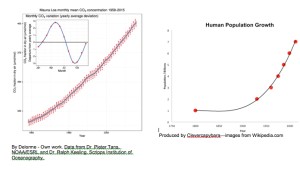Please note the two curves above. Although the graph of CO2 concentration in the atmosphere (Keeling curve) on the left starts in 1958 and the one on the right (human population) starts in 1800, they follow the same trajectory of steep increase over the past 50+ years.
“It is difficult to get a man to understand something, when his salary depends on his not understanding it.â€
Upton Sinclair
           A recent Letter to the Editor of the Herald got my attention. It would seem that its author and I are living on different planets.
The writer calls Dr. James Hansen’s statement that the world would “overheat†because of carbon emissions “a ridiculous assertionâ€. NASA has a web page devoted to statements from our country’s foremost scientific organizations. For instance, the American Association for the Advancement of Science states: “The scientific evidence is clear: global climate change caused by human activities is occurring now, and it is a growing threat to society.”
The LTE was in response to Herald article about the wager between Roger Cohen and me. Dr. Cohen (former manager of strategic planning at Exxon Mobil) earned a PhD in physics and is a member of the American Physical Society, which states: “The evidence is incontrovertible: Global warming is occurring.â€
Let’s go back to the other planet where the writer of the LTE seems to be living. He asserts that polar bears are thriving. The International Union for the Conservation of Nature lists the status of polar bears as “vulnerableâ€, This would not lead me to believe that they are thriving. Dr. Steven Amstrup, head scientist with Polar Bears International, wrote: “One of the most frequent myths we hear about polar bears is that their numbers are increasing and have, in fact, more than doubled over the past thirty years.â€
“The polar ice caps, both of them, are robust†according to this LTE. Unfortunately, Earth’s ice caps are not healthy. Indeed, a large freighter recently navigated the fabled Northwest Passage through the Arctic Ocean!
There is mixed news from Antarctica. Although ice in west Antarctica is melting, the amount of ice is increasing over the continent. That is a bit of a paradox since the average temperature there has gone up by almost 1 degree Fahrenheit—but it is just so darn cold in Antarctica.
Studies find rising levels of CO2 help some plants but hinder others. Studies of phenology (when plants and animals wake up after the winter) find that climate change is already causing problems that may lead to decreased crop productivity. Many places in the world are experiencing decreased precipitation from climate change. Overall, the bonus of increased CO2 seems to be overwhelmed by other aspects of climate change.
The LTE ends up by stating “…the standard of living of some of the world’s poorest of the poor has risen because of increased vegetation to feed themselves and their animals….†Try telling that to the people who are starving in Madaya—where the Syrian revolution was triggered, in part, by drought caused by climate change. The Horn of Africa is also suffering from chronic malnutrition, as are many other places in Africa and Asia. Drought caused by climate change has worsened starvation in these places. Although the percentage of people who are undernourished in the world has decreased, the improvement is not generally attributed to increased CO2.
People are also suffering from climate change closer to home. Residents of Isle de Jean Charles, Louisiana, will be relocated because their community is disappearing under the rising ocean.
What I find amazing is that, although people deny climate change (or perhaps deny that climate change is anthropogenic), I have yet to read any refutation of the observation that the atmospheric concentration of CO2 is rising, and that its rise is anthropogenic. We all understand that this gas, along with methane and water vapor, are greenhouse gases. Without GHGs our planet Earth would be 60 degrees Fahrenheit colder—and totally unable to support life. Doesn’t it make sense that, as the CO2 level rises, the temperature will also rise?
Perhaps we can excuse some of the denial of climate change thanks to the findings of a recent study of people’s reaction to the climate. Apparently the warming that we in the USA have experienced actually has made the climate more agreeable—although that is far from true in other parts of the world.
Greenhouse gases released by people cause climate change; the more people, the faster the climate will change. Family planning is part of the solution! Another part of the solution is convincing our political representatives to support legislation to slow climate change. The Citizens’ Climate Lobby (http://citizensclimatelobby.org) has an effective plan to do this. A local chapter has just been formed; you can contact them at: durangoccl@gmail.com.
© Richard Grossman MD, 2016

